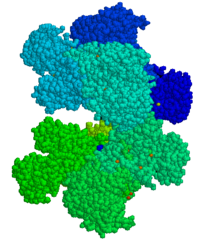
Photo from wikipedia
Abstract Glucose-6-phosphate dehyrdgoenase (G6PD) deficiency is a common X-linked genetic trait, with an associated enzyme phenotype, whereby males are either G6PD deficient or normal, but females exhibit a broader range… Click to show full abstract
Abstract Glucose-6-phosphate dehyrdgoenase (G6PD) deficiency is a common X-linked genetic trait, with an associated enzyme phenotype, whereby males are either G6PD deficient or normal, but females exhibit a broader range of G6PD deficiencies, ranging from severe deficiency to normal. Heterozygous females typically have intermediate G6PD activity. G6PD deficiency has implications for the safe treatment for Plasmodium vivax malaria. Individuals with this deficiency are at greater risk of serious adverse events following treatment with the only curative class of anti-malarials, 8-aminoquinolines, such as primaquine. Quantitative diagnostic tests for G6PD deficiency are complex and require sophisticated laboratories. The commonly used qualitative tests, do not discriminate intermediate G6PD activities. This has resulted in poor understanding of the epidemiology of G6PD activity in females and its corresponding treatment ramifications. New simple-to-use quantitative tests, and a momentum to eliminate malaria, create an opportunity to address this knowledge gap. While this will require additional resources for clinical studies, adequate operational research, and appropriate pharmacovigilance, the health benefits from this investment go beyond the immediate intervention for which the G6PD status is first diagnosed.
Journal Title: International Health
Year Published: 2019
Link to full text (if available)
Share on Social Media: Sign Up to like & get
recommendations!